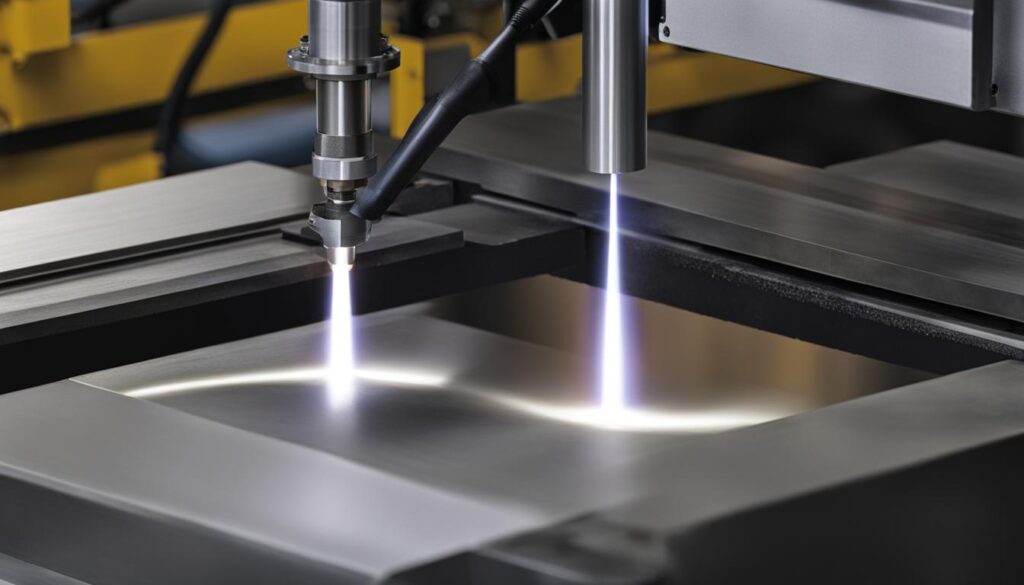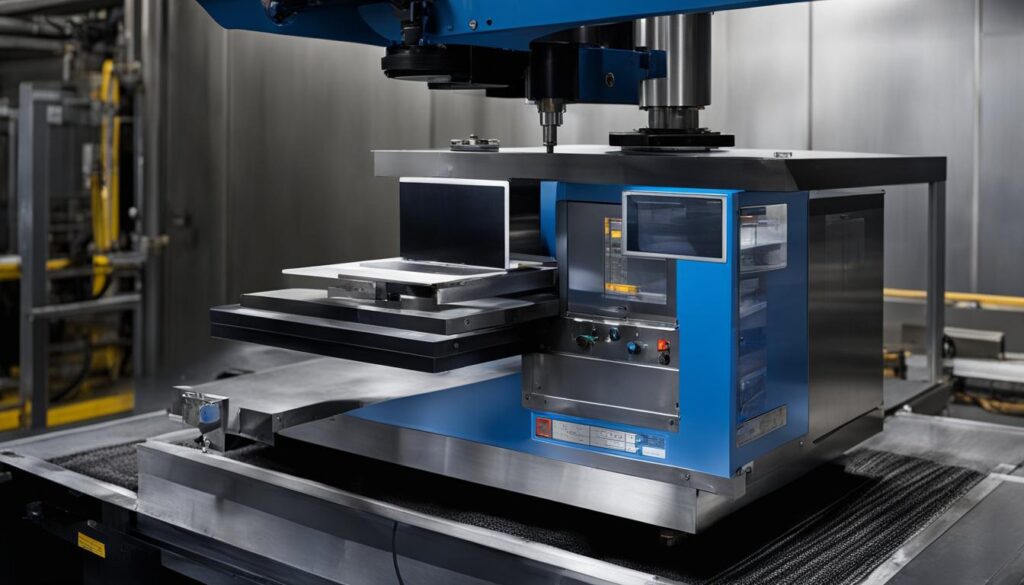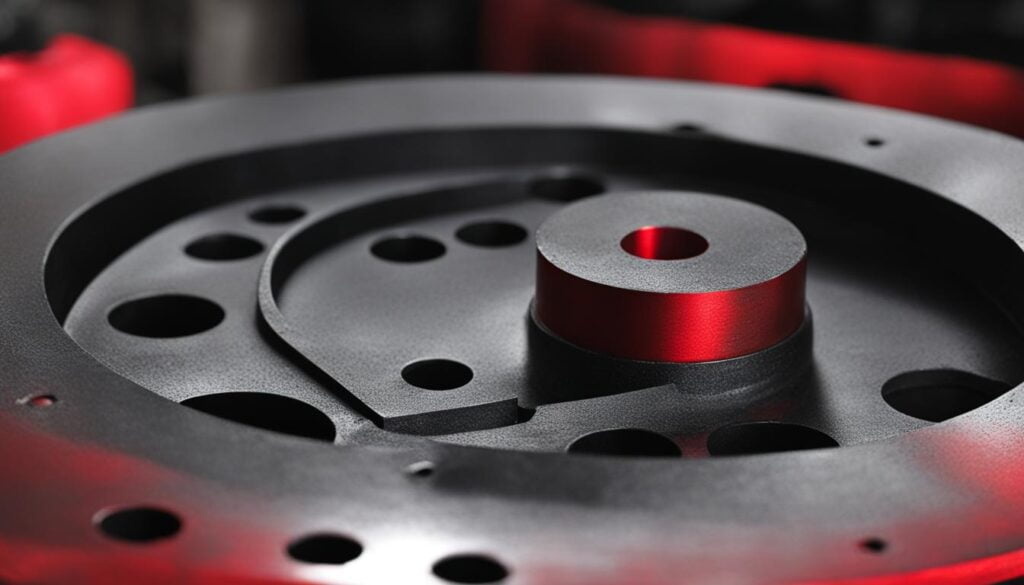At KT-Foundry, we employ a comprehensive set of defect detection methods to identify and address imperfections in carbon steel castings. Our quality control techniques are rooted in globally recognized industry standards published by ASTM International, ASME, and ISO. These standards advocate for a suite of Non-Destructive Testing (NDT) methods including Magnetic Particle Testing (MT), Liquid Penetrant Testing (PT), Eddy Current Testing (ECT), and Eddy Current Array (ECA) to efficiently detect surface-breaking defects in carbon steel structures and ensure the delivery of superior quality products.
Key Takeaways
- KT-Foundry implements comprehensive defect detection methods in carbon steel casting.
- Quality control techniques adhere to globally recognized industry standards published by ASTM International, ASME, and ISO.
- Non-Destructive Testing (NDT) methods include Magnetic Particle Testing (MT), Liquid Penetrant Testing (PT), Eddy Current Testing (ECT), and Eddy Current Array (ECA).
- These methods aim to efficiently detect surface-breaking defects in carbon steel structures.
- Employing NDT methods contributes to delivering superior quality products in carbon steel casting.
Embracing Industry Standards for Carbon Steel Inspection
Our adherence to the industry standards set forth by authoritative bodies like ASTM International, ASME, and ISO ensures that our inspection processes for carbon steel casting maintain the highest integrity. These standards dictate specific guidelines for appropriate defect detection, and our comprehensive inspection methodologies are designed to evaluate surface-breaking defects with precision, thereby safeguarding the quality of our castings.
By complying with these globally recognized benchmarks, we are able to achieve consistent and superior casting quality across our product lines. The following table provides an overview of the various industry standards that pertain to carbon steel inspection:
| Organization | Standard | Scope |
|---|---|---|
| ASTM International | ASTM A802/A802M | Standard Practice for Steel Castings, Surface Acceptance Standards, Visual Examination |
| ASME | ASME B16.34 | Valves – Flanged, Threaded and Welding End |
| ISO | ISO 11971 | Steel and Iron Castings – Visual Testing of Surface Quality |
Implementing and adhering to these industry standards not only ensures compliance with global manufacturing norms but also demonstrates our unwavering commitment to delivering products that meet and exceed the requirements of our customers.
Our approach to carbon steel inspection is underpinned by an allegiance to internationally recognized standards, empowering us to achieve excellence in each casting we produce.
At the core of our inspection processes lies a remarkable level of detail and consistency, supported by:
- Comprehensive training of our skilled inspectors
- Effective communication of inspection requirements and standards
- Utilization of advanced defect detection tools and equipment
- Continuous monitoring and improvement of our quality management system
In conclusion, aligning our carbon steel inspection processes with the industry standards set forth by organizations like ASTM International, ASME, and ISO ensures that we maintain the highest integrity when evaluating surface-breaking defects. This unwavering commitment to precision and quality safeguards the integrity of our castings, solidifying our position as a trusted partner in the carbon steel casting industry.
Unlocking the Potential of Magnetic Particle Testing (MT)
Magnetic Particle Testing (MT) is a proven and valuable technique for detecting flaws in carbon steel castings. Providing a range of advantages and considerations, MT enables efficient inspection of ferromagnetic materials while maintaining cost-effectiveness and ease of use.
Advantages of Magnetic Particle Testing for Carbon Steel Castings
MT offers several benefits when it comes to flaw detection in carbon steel castings, making it a preferred choice for many inspection processes. Some of these advantages are:
- Cost-effective and efficient: MT can deliver fast and accurate results without being overly expensive, making it a popular choice for large scale inspection.
- Versatile: Capable of inspecting objects of various sizes and shapes, MT allows for flexibility in the inspection process.
- Ferromagnetic materials inspection: MT is particularly advantageous for inspecting ferromagnetic materials where magnetic flux leakage can indicate defects.
MT’s ability to provide near-instant results and its adaptability for various object sizes make it an ideal solution for detecting flaws in carbon steel castings.
Considerations and Limitations of Magnetic Particle Testing
Despite its many advantages, MT comes with certain limitations that need to be considered to ensure reliable and accurate inspection:
- Restricted to ferromagnetic materials
- Requires surface preparation and post-cleaning
- Not suitable for use over thick coatings
- Unsuitable for computerized record-keeping scenarios
- Messy process in certain conditions
- Dependent on direct electricity
- Potential for irrelevant indications requiring skilled interpretation
Being aware of these limitations ensures that MT is utilized effectively and appropriately in carbon steel casting inspection processes.
| Advantages | Limitations |
|---|---|
| Cost-effective and efficient | Restricted to ferromagnetic materials |
| Versatile | Requires surface preparation and post-cleaning |
| Ferromagnetic materials inspection | Not suitable for use over thick coatings |
| Near-instant results | Unsuitable for computerized record-keeping scenarios |
| Simple process | Messy under specific conditions |
| Skilled interpretation not always required | Dependent on direct electricity |
| Potential for irrelevant indications |
In summary, Magnetic Particle Testing offers numerous advantages in defect detection for carbon steel castings, but it is important to consider its limitations to ensure the most effective and accurate inspection outcomes.
Enhancing Visibility of Defects with Liquid Penetrant Testing (PT)
Liquid Penetrant Testing (PT), also known as Dye Penetrant Inspection (DPI) or Liquid Penetrant Inspection (LPI), is lauded for its ability to highlight small defects on the surface of non-porous materials. This inspection technique relies on capillary action to enhance visibility of surface-breaking defects when dealing with carbon steel castings. It’s an uncomplicated, economical method that is also portable, allowing it to be used in diverse settings.
Liquid Penetrant Testing uncovers even the smallest surface-breaking defects in carbon steel castings using capillary action.
However, Liquid Penetrant Testing comes with its own set of challenges. Critical among these is the need for meticulous pre-cleaning to ensure the removal of any surface contaminants that could hinder the inspection process. Additionally, this method is limited to inspecting relatively non-porous surfaces with direct access to the area being evaluated.
The procedure for Liquid Penetrant Testing can be summarized in the following steps:
- Pre-cleaning the surface of the carbon steel casting to be inspected
- Applying the penetrant to the surface
- Allowing the penetrant to dwell on the surface for a specific period
- Removing excess penetrant from the surface
- Applying the developer and allowing it to dwell for a specific period
- Inspecting the surface under proper lighting conditions for the appearance of indications
Although Liquid Penetrant Testing may not be suitable for all circumstances, it remains a reliable and accessible resource in detecting surface-breaking defects in carbon steel castings. By incorporating Liquid Penetrant Testing into our quality control process, we are better equipped to uphold stringent industry standards and maintain our commitment to delivering defect-free products to our customers.
Delving into Eddy Current Testing (ECT) for Superior Detection
Eddy Current Testing (ECT) has evolved as a powerful Non-Destructive Testing (NDT) technique that utilizes electromagnetic induction to identify both surface and subsurface inconsistencies in carbon steel castings.

The Evolution and Advantages of Eddy Current Testing
Initially developed in the early 20th century, ECT has undergone significant technological advancements to transform into the efficient and reliable tool it is today. Leveraging electromagnetic induction, ECT offers a myriad of advantages:
- Sensitivity to various defect types, including surface cracks, pits, and subsurface flaws.
- Capability to test multilayer structures and conduct thickness measurements.
- Minimal pre-cleaning requirements, leading to a streamlined inspection process.
- Provision of portable, lightweight equipment, enabling use across diverse applications.
- Compatibility with conductive materials, including carbon steel castings.
These advantages position ECT as a critical tool for ensuring the structural integrity and quality of carbon steel castings.
Below is a table detailing the effectiveness of ECT in detecting various types of defects present in carbon steel castings:
| Defect Type | Effectiveness of ECT |
|---|---|
| Surface Cracks | High |
| Subsurface Cracks | High |
| Pits and Porosity | Medium to High |
| Inclusions | Low to Medium |
| Thickness Variations | High (with specialized probes) |
Although ECT encounters certain limitations related to material properties and signal penetration depths, its accuracy in locating and sizing various types of defects make it an indispensable technique for maintaining the quality of carbon steel castings.
“Eddy Current Testing has transformed into an efficient and reliable tool for detecting both surface and subsurface inconsistencies in carbon steel castings.”
In conclusion, ECT’s sensitivity to a wide range of defects, testing versatility, and user-friendly nature makes it a vital component of a comprehensive defect detection strategy for carbon steel castings.
Extending Capabilities with Eddy Current Array (ECA)
Building upon the impressive qualities of Eddy Current Testing (ECT), the Eddy Current Array (ECA) has emerged as a valuable enhancement for defect detection in carbon steel castings. By employing multiple coil elements arranged in a probe, ECA can inspect larger areas in a single pass, significantly improving efficiency while maintaining high-resolution capabilities.
Distinguishing Features of ECA in Defect Detection
ECA’s unique attribute lies in its multiplexing technology, which minimizes mutual inductance and maximizes resolution for optimal defect detection in carbon steel castings. Key benefits of ECA technology include:
- Large area inspection in a single pass
- Enhanced defect detection efficiency
- Detection of surface-breaking cracks in difficult-to-reach areas
- Applicable to complex geometries and structures
The Tangential Eddy Current Array (TECA™) Advantage
As a breakthrough in crack detection technology, the Tangential Eddy Current Array (TECA™) offers precise identification of surface-breaking cracks, specifically in carbon steel welds. By combining tangential and pancake coils, TECA™ utilizes a unique signal generation to accurately size the depth of these defects.
Transmitters in TECA™ induce perpendicular eddy currents that present as a distinctive response when encountering longitudinal cracking.
This innovative approach allows professionals in the carbon steel casting industry to maintain the highest quality standards for their products while staying ahead of the curve with the most advanced defect detection techniques available.
Ultrasonic Testing: A Deep Dive into Internal Defect Analysis
As an indispensable tool in the NDT arsenal, Ultrasonic Testing is renowned for its precision and accuracy in identifying internal inconsistencies, such as shrinkage cavities and porosity within carbon steel castings. Through its advanced capability to direct ultrasound beams and evaluate propagation reflectivity, Ultrasonic Testing offers high-resolution inspection and localization of defects.

Ultrasonic Testing Techniques: Ensuring Precision and Accuracy
One of the key techniques in Ultrasonic Testing is the Pulse Reflection Method, which allows for a detailed analysis of casting interiors. This groundbreaking methodology enhances Internal Defect Analysis and Defect Characterization, thus playing a vital role in quality control and assurance.
Ultrasonography in Castings involves propagation of high-frequency sound waves to detect and localize defects based on their unique pulse reflections on flaw detectors.
The Science Behind Ultrasonic Testing in Carbon Steel Castings
The scientific foundation of Ultrasonic Testing is rooted in the capacity of high-frequency sound waves to reveal various defects by generating distinctive pulse reflections on flaw detectors. Alongside NDT Science-based techniques, Ultrasonic Testing effectively detects flaws in carbon steel castings that elude other conventional methods. However, the method’s sensitivities can be influenced by factors such as ultrasonic frequency, equipment performance, and surface finish.
For optimal inspection results, it’s crucial to maintain a smooth surface finish with an appropriate coupling medium. This facilitates effective ultrasonic inspection on carbon steel castings, ensuring accurate and high-quality results.
- A proper coupling medium helps transmit ultrasound waves between the probe and the material being tested, improving signal quality.
- Smooth surface finishes reduce the amount of high-frequency noise generated on the surface due to scattering, allowing for better detection and localization of defects.
- Appropriate equipment performance, including probes and flaw detectors, contributes to the reliability of Ultrasonic Testing outcomes.
In conclusion, Ultrasonic Testing stands as a robust solution for Internal Defect Analysis in Carbon Steel Castings. By leveraging innovative techniques, such as the Pulse Reflection Method, Ultrasonic Testing guarantees superior precision and accuracy in identifying and characterizing defects in casting interiors, thus upholding the highest quality standards.
Ensuring Quality and Integrity in Carbon Steel Castings
At KT-Foundry, our commitment to quality assurance and maintaining the integrity of carbon steel castings is evident in our rigorous application of Non-Destructive Testing (NDT) best practices. We employ a comprehensive set of defect detection methods, including Magnetic Particle Testing (MT), Liquid Penetrant Testing (PT), Eddy Current Testing (ECT), Eddy Current Array (ECA), and Ultrasonic Testing (UT). These techniques enable us to identify and address imperfections in carbon steel castings efficiently and effectively.
By adhering to industry standards set forth by authoritative bodies like ASTM International, ASME, and ISO, we ensure that our inspection processes for carbon steel casting maintain the highest integrity. Our inspection methodologies are designed to evaluate surface-breaking defects with precision, thereby safeguarding the quality of our cast products.
In conclusion, our continuous efforts to stay Beyond Current and implement the most suitable combination of NDT methods demonstrate our dedication to delivering reliable, defect-free carbon steel castings to our customers. At KT-Foundry, we take pride in our unwavering commitment to ensuring the best possible quality and upholding carbon steel casting integrity, while providing innovative NDT solutions for all our projects.
FAQ
What industry standards does KT-Foundry follow for carbon steel inspection?
KT-Foundry adheres to globally recognized industry standards published by ASTM International, ASME, and ISO. These standards dictate specific guidelines for appropriate defect detection in carbon steel castings.
What are some advantages and limitations of Magnetic Particle Testing (MT)?
Advantages of MT include its cost-effective approach, versatility for inspecting various sizes and shapes, and efficiency in detecting flaws in ferromagnetic materials. Limitations include its restriction to ferromagnetic materials, need for surface preparation and post-cleaning, unsuitability over thick coatings or in computerized record-keeping scenarios, and potential for irrelevant indications which require skilled interpretation.
How does Liquid Penetrant Testing (PT) enhance visibility of defects in carbon steel castings?
Liquid Penetrant Testing (PT), also known as DPI or LPI, utilizes capillary action to highlight small defects on the surface of non-porous materials, making them more visible. It’s an economical and portable method that can be used in a variety of settings.
What are the key advantages of Eddy Current Testing (ECT) for defect detection in carbon steel castings?
ECT offers several advantages for detecting defects in carbon steel castings, such as sensitivity to various types of defects, ability to test multilayer structures, minimal pre-cleaning requirements, and provision of portable, lightweight equipment.
How does Eddy Current Array (ECA) technology improve the efficiency of defect detection in carbon steel castings?
Eddy Current Array (ECA) utilizes multiple coil elements arranged in a probe, allowing it to inspect a larger area in a single pass. This leads to increased efficiency and higher resolution in identifying defects and flaws in carbon steel castings.
What is the Tangential Eddy Current Array (TECA™) advantage in detecting surface-breaking cracks?
TECA™ combines tangential and pancake coils to precisely identify surface-breaking cracks, specifically in carbon steel welds. It uses unique signal generation to size the depth of these defects, allowing for more accurate analysis of the casting’s integrity.
How does Ultrasonic Testing ensure precision and accuracy in identifying internal defects in carbon steel castings?
Ultrasonic Testing uses high-frequency sound waves to reveal various defects based on their unique pulse reflections on flaw detectors. Techniques like the pulse reflection method allow for detailed analysis and localization of internal defects such as shrinkage cavities and porosity, ensuring high-resolution inspection of casting interiors.


